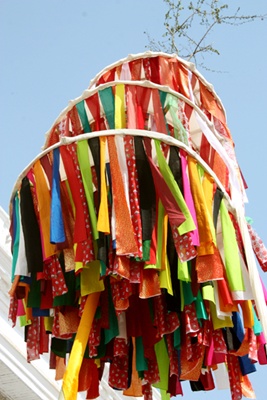Holi is one of the many festivals celebrated by Hindus in Nepal. It is also known as Phagu Purnima which is a festival of colours.
Holi is celebrated in two days in Nepal, today as Phagu Purnima (except in Terai) and tomorrow in Terai region as Holi.
People install Holi pole, “Chir’, a bamboo pole, fringed with strips of cloth representing good luck charms indicating the arrival of the Holi festival. This Chir pole is erected a week before the Holi festival is celebrated at all the three heritage squares of Nepal namely Kathmandu Durbar Square, Bhakatpur Durbar Square and Patan Durbar Square. Once the erecting is done, people throw red vermillion powder in the air as the symbol to mark the beginning of Holi, a time for fun and frolic. It is said to symbolize the tree on which lord Krishna hung the milkmaids’ garments while they were bathing. At the end of the festivities the Chir is taken to a bonfire.
Here are some of the legends behind Holi (source: internet)
There is a popular legend behind the installation of Chir. The story is again about the mischievous nature of Lord Krishna who loved to play pranks with the milkmaids or gopis. Playful as he was, it is said that once he seduced all the local girls with his dashing good looks. He then danced with them all and when they were fully engrossed in him, then he thought they were ripe for a tease. He doused them in coloured water and stole all their clothes while they were bathing in the water of river Yamuna. Naughty Krishna then hung their clothes on a tree to bug them. Chir symbolizes that very tree.
Another myth following Holi, reveals that a fiend named Holika together with her brother, an atheist king by the name of Hiranyakasyapu conspired to kill his son Pralhad because Pralhad was an ardent devotee of Lord Vishnu. But their attempts always failed for Lord Vishnu protects those who love him. Finally, Holika who having received a blessing from Lord Bramha to be immune to fire, jumped in a bonfire with Pralhadin her lap. But Brahma’s blessing could only be used for
good purposes and so Holika was consumed by the fire where as Pralhad was saved by the grace of the Gods. Thus, Holi is said to be celebrated to rejoice Holika’s extermination and the traditional bonfires are believed to commemorate her death.
Yet another legend says that there was an Ogress known as Putna. Lord Krishna’s devil uncle Kansa seeked the help of Putna to kill infant Krishna by feeding him poisonous milk.Putna disguised herself as a simple and pious woman and treacherously fed baby Krishna with her poisoned breast. Lord Krishna, however, sucked her blood which revealed the monster behind that pious woman and laid her to death.
 On the night before Holi, there is a practice to burn an effigy of Putna – the Ogress who nearly killed Lord Krishna. The tradition is symbolic of victory of divinity over demonic forces. It also shows the end of winter and darkness – as typified by Putna.
On the night before Holi, there is a practice to burn an effigy of Putna – the Ogress who nearly killed Lord Krishna. The tradition is symbolic of victory of divinity over demonic forces. It also shows the end of winter and darkness – as typified by Putna.
I used to love Holi while growing up. It used to be a few days off from school and we loved playing will lola (water filled balloons) and abeer (colours). It was time of fun and frolic. People spent the day smearing coloured powder all over each other’s faces, throwing coloured water at each other, having parties, and dancing.
The only drawback of Holi in Kathmandu is for young girls and women who get lola thrown at them everywhere they go. I remember being bombarded by hundreds of balloons from someone’s roof top on the way to school or on the way back. It was days before the real Holi and it used to piss me off. Can you imagine, you are going somewhere and you are drenched with water from these balloons? Also as you know clean water is not available easily in Nepal so I am not even sure, what kind of water they used. I used to fight with these people who spoiled the real meaning of Holi.
If you are in Nepal, hope you are having a great time.
Sydney is celebrating Holi at the end of the month so hoping to go and have some fun then.
Happy Holi everyone !!!
































